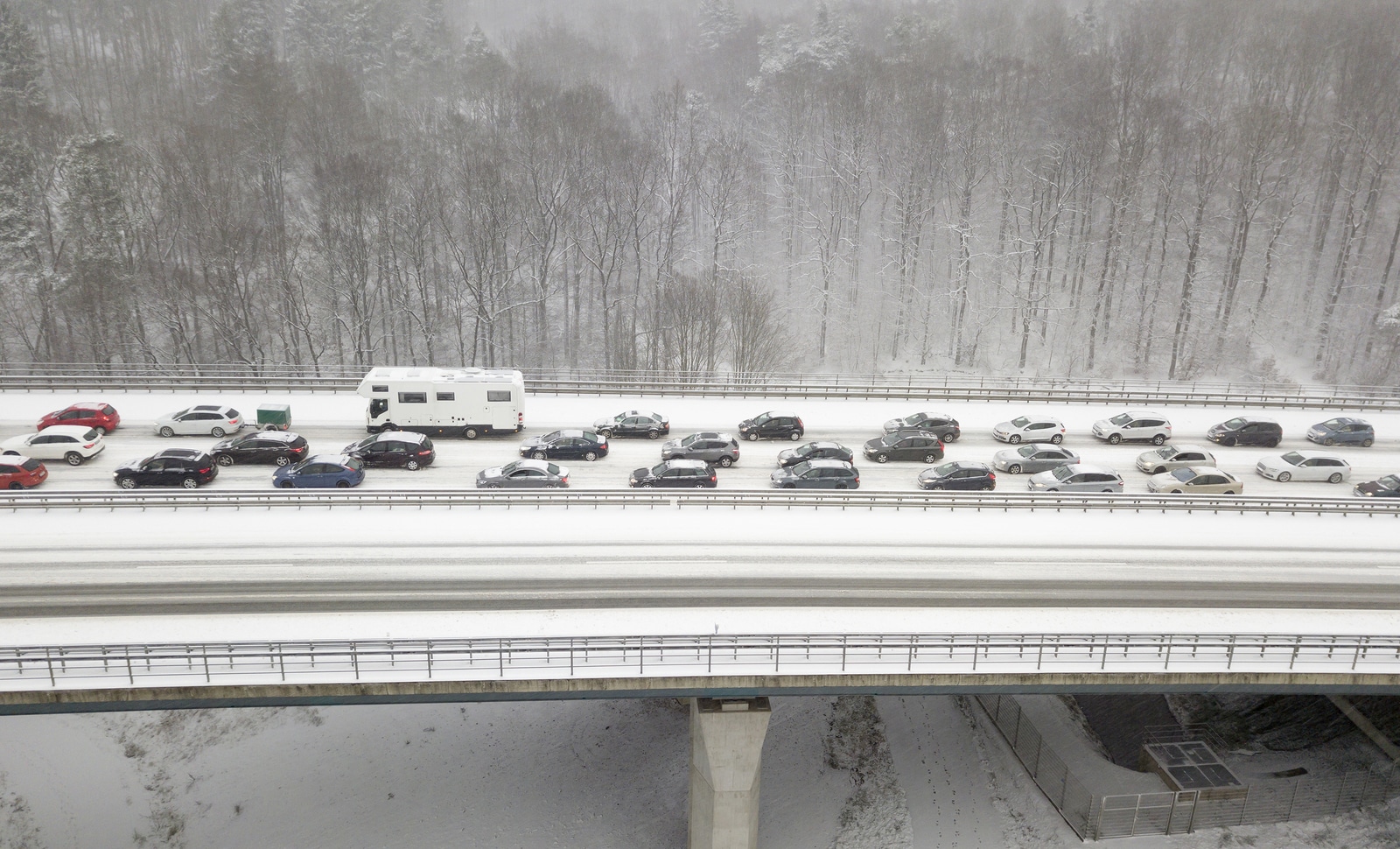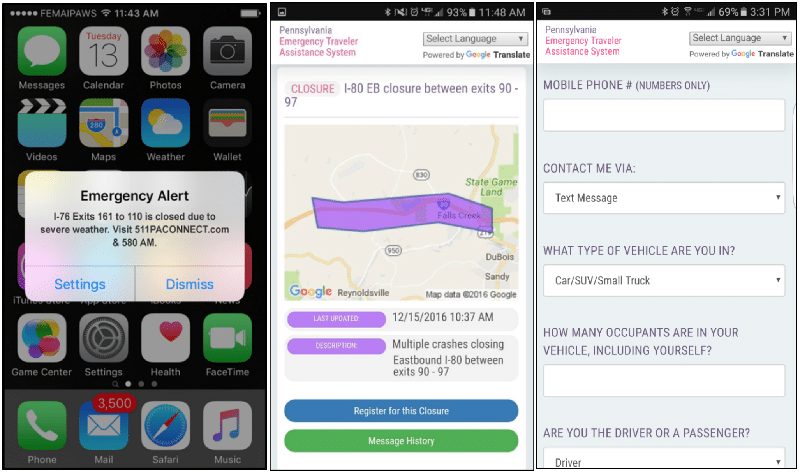
GUEST POST:
Rick Schuman, VP of Public Sector, INRIX
John Farrell, Product Management Director, Information Logistics
As the award-winning 511PA Connect service [1] celebrates its two-year operating anniversary this holiday season, we want to both look back at its accomplishments, and look forward for what is to come for the service, and our HELP [2] (Highway Emergency Link Platform) service that makes these capabilities available to agencies nationwide.
511PA Connect: Its Genesis
511PA Connect was conceived by key agencies in Pennsylvania including PennDOT and the PA Turnpike Commission after February 2016’s Winter Storm Jonas, one of those storms-of-the-century that seem to happen every year now. During Jonas, multiple long-term ‘trapped queues’ formed across the state, with hundreds of vehicles and thousands of people stuck on major interstates, some for nearly 24 hours. After action reviews, including the Governor, drove home to the agencies just how little situational awareness they had to conditions on the ground – how little any public sector agency has in these events. But with hard work by the agencies and its contractor Information Logistics, and the support of Governor Wolf, by the following winter 511PA Connect was in place to facilitate communications with drivers stuck in queues, and to allow agencies to gain their first true picture of conditions to more effectively manage these events. [3]
The key innovation was leveraging FEMA’s Wireless Emergency Alert (WEA) service to initiate two-way communications with those stuck – no apps needed – allowing travelers to register as ‘trapped’ to facilitate ongoing text/email/web/IVR communications until the situation is resolved. First introduced in 2012, WEAs are supported by all major wireless carriers and work across nearly all active phones in the US, and since WEAs have priority, wireless network congestion doesn’t impact the ability to distribute an alert. Below are screenshots from an activation, with the initial WEA alert on the left, the home web page for the activation in the middle, and the traveler registration page on the right.

511PA Connect’s First Two Years
From the outset, PennDOT, PTC, PEMA and the PA State Police established specific rules for when 511PA Connect is activated laid out in a Standard Operating Procedure document – a key ‘rule’ is if the trapped queue is expected to last 4 hours or longer. Since December 2016, 511PA Connect has been activated for 39 different events. While most are tied to winter weather, this is not exclusively the case. On average, nearly 100 vehicles with nearly 300 occupants ‘register’ during each activation. Some noteworthy statistics include:
- Maximum number of vehicles registered in an activation: 731
- Maximum number of vehicle occupants registered in an activation: 3,230
- Maximum number of motorcoaches/school busses in an activation: 35
- Maximum Simultaneous activations (more than one trapped queue at a time): 4
For each activation, a documented summary is automatically generated and retained (maintaining traveler anonymity as all phone numbers are scrambled after the event has ended). This is crucial for after action reviews to improve both 511PA Connect and incident management procedures in general.
511PA Connect’s Evolution
While 511PA Connect was developed with the intention of providing basic communication during trapped queue events, this “simple” idea has evolved to a robust incident management platform. In addition to basic SMS text and IVR capabilities, the system was given the ability to survey participants, pinpoint locations, and present data in formats that allow agencies to more effectively plan their response. Interfaces were developed to monitor incoming text messages for urgent alerts and trends, and methods for capturing user location data have been upgraded several times.
These, and many other enhancements over the first two years of the system, have come from real life use cases, and feedback from the agency operators. Among the most critical of these was the development of what we call “preemptive” alerts. These are WEA messages, sent from the HELP platform, that send a critical warning to drivers, but do not prompt them to go to the website or register for the two-way communications portion of the system. This is a way to get a safety message to a large group of drivers in a short time. This feature was used by the PA Turnpike in January of 2017, when an emergency closure temporarily suspended traffic on the bridge between the PA and NJ Turnpike systems.
The system has also been enhanced thanks to the addition of INRIX data. All of the system’s maps natively display the INRIX XD traffic layer, which is quite helpful for situational awareness of the impact of closures on an area. Additionally, INRIX’s automatic queue detection data can also be layered onto the HELP maps. This assists TMC administrators in determining the size of the area that should be selected for the WEA distribution, particularly in rural areas that may not have terrific camera coverage. With the INRIX data, they can see the automatically-detected length of the queue, and combine this with their unique knowledge of the roadway to make a very educated determination of the target area for the WEA.
These are the kinds of enhancements that make the system even more beneficial to each additional agency that participates.
511PA Connect leads to HELP
Information Logistics (ILog) developed and maintains the cloud-based platform that powers 511PA Connect. As announced this June, INRIX has teamed exclusively with ILog to offer this turn-key service to other states nationwide – now including INRIX real-time traffic, queue monitoring and dangerous slowdown locations. Branded HELP, the Highway Emergency Link Platform, the service is available for use across the entire US, with required coordination with FEMA and the major wireless carriers already completed. HELP can be configured and go-live for a state in as short as a few weeks, and can be branded as the state desires.
For agencies in the I-95 Corridor Coalition, an innovative contracting mechanism is available. HELP has been added to INRIX’s Vehicle Probe Project contract as an ‘Ancillary Product,’ with use terms and discounted pricing negotiated. Member agencies can enter into or expand an existing agreement with the Coalition and the University of Maryland for a HELP subscription following the model used by many agencies over the past decade for INRIX’s real-time speed/travel time data.
The Next Two Years
While WEA capability has existed for years (this is how Amber and Emergency Weather Alerts are sent to your phone), earlier this year, the FCC updated regulations that will further increase WEA usefulness for highway applications. [4] By May 1, 2019, participating wireless carriers must support a 360-character maximum length (from the current 90), enable active URLs and telephone numbers in the WEA, and Spanish-language messages. By November 30, 2019, participating carriers must improve ‘geo-targeting’ to deliver alerts with only a 0.1-mile overspill from the target area, and require that devices be able to cache previous alerts for at least 24 hours. While the implementation of these features will vary by carrier and region, what is clear is that all of these capabilities will be in place for all major carriers a year from now.
The improved geo-targeting of alerts is a particularly exciting development for HELP – as it will provide confidence to agencies that alerts will reach their desired area, while minimizing false alarms to others. This bodes well for expanded and creative uses of pre-emptive safety alerting as highlighted earlier.
Every State Should have HELP
If you are a TSMO professional, imagine this image below is available at your operations center as a major incident unfolds in a remote area of the network with vehicles and their inhabitants being trapped on an interstate that is turned into a parking lot – with each dot representing a registered trapped vehicle. Imagine establishing situational awareness in a location with no ITS infrastructure, ensuring an overloaded emergency response addressing those most in need, communicating with those trapped to provide both vital information and peace of mind, and managing traffic flow upstream of the danger area to reduce the chance of further crashes.

References:
[1] https://www.511pa.com/511paconnect.aspx
[2] https://inrix.com/press-releases/help-alerts/
[3] For the first excellent public presentation about 511PA Connect in January 2017, see pages 132-144 here: https://i95coalition.org/wp-content/uploads/2017/01/TISPTC_Mtg_19jan2017-Presentation.pdf?x70560
[4] A good summary of the January 2018 FCC Rulemaking is here: https://www.recode.net/2018/1/30/16950464/fcc-wireless-emergency-smartphone-alerts-hawaii




